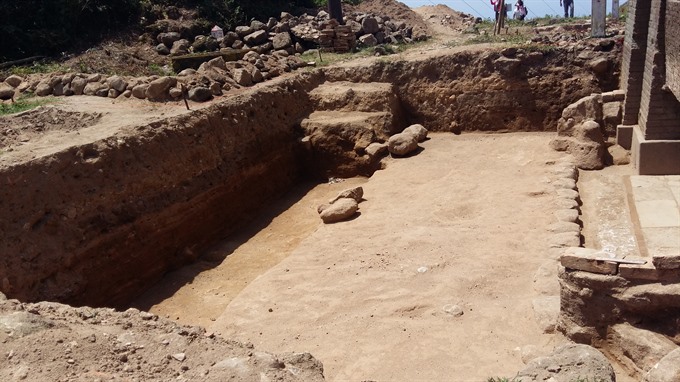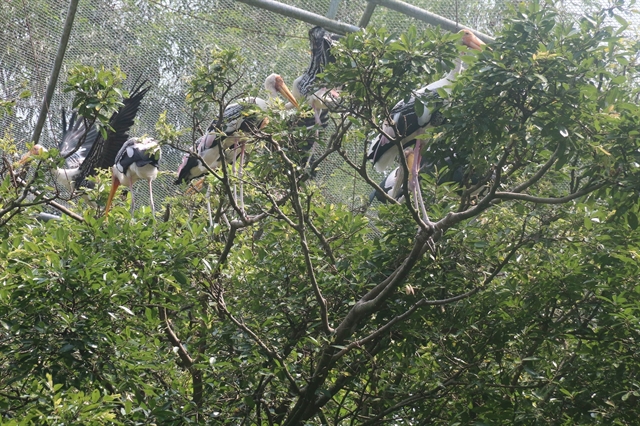 Life & Style
Life & Style

An excavation unearthed a section of foundation and wall of trench on the west and south of the Điện Hải Citadel in the city’s downtown following a restoration project starting last month.
 |
| Excavated: A brick wall section of trench is excavated on the west side of the Điện Hải Citadel in Đà Nẵng city. — VNS Photo Lê Lâm |
ĐÀ NẴNG — An excavation has unearthed a section of the foundations and walls of a trench on the southwest of the ruined Điện Hải Citadel in the city’s downtown district following a restoration project that began last month.
Director of Đà Nẵng Museum Huỳnh Đình Quốc Thiện said the first excavation exposed a 126m wall section on the west of the citadel, which was built by brick and mortar.
A section of foundations 14.2m long and 4.2m wide was also found next to the citadel wall on the west side. This foundation was built from laterite and pebble.
The excavation team suggested measuring the original section of the wall and foundation, and dismantling broken or damaged brick sections for restoration, Thiện said.
The wall of the trench will be restored to fit the primary plan of the citadel, Thiện said on Friday.
The team will have to revaluate the section of foundation on the west side of the citadel, due to a lack of original documents and drawings.
 |
| Natural beauty: An overview of the Hải Vân Gate with two brick gates and some bunkers left from the war time. — VNS Photo Công Thành |
According to the national heritage council, the ruins of the citadel may be the last monument in Đà Nẵng that symbolises the sacrifice of local people and soldiers in the fight against French-Spanish colonial forces in 1858-60.
The citadel, which was recognised as a National Special Relic, is a link to Nguyễn Tri Phương (1800-73), a famous general who commanded a Vietnamese army to fight the foreign invaders.
The city still preserves the graveyard of French-Spanish coalition soldiers who died during the 1858-60 fighting.
The citadel, which is now the site of the city’s museum on Trần Phú Street, was first built as a military outpost in the twelfth year of King Gia Long’s reign (1813), near the mouth of the Hàn River, to control access to Đà Nẵng Port and serve as an important defensive position.
It was renamed the Điện Hải Citadel in 1835, the fifteenth year of King Minh Mạng’s reign, after it was moved inland and rebuilt on a high mount in 1823, during the fourth year of Minh Mạng’s reign.
The citadel still has a moat between two brick walls and a cannon collection displayed outdoors. It has a total dimension of 653m, including two layers of walls (5.64m high inner walls and 3.29m outside wall) and a trench system 21.15m wide and 3.29m deep.
A collection of 11 iron cannons cast during the Nguyễn Dynasty between 1802 and 1860 and unearthed at the Điện Hải Citadel between 1979 and 2008, is planned for recognition as a national treasure.
 |
| Relic: The north gate of Hải Vân sits on the top of Hải Vân Pass. — VNS Photo Công Thành |
Hải Vân Gate
Another excavation began on an area of 600sq.m on the Hải Vân Gate on the Hải Vân Pass in the border of Thừa Thiên-Huế Province and Đà Nẵng City in a restoration project.
The Hải Vân Gate was recognised as National Historical Relic last year.
The Hải Vân Gate, situated on the top of Hải Vân Pass, is a complex of brick-built gates dating from the Trần Dynasty (1470), and octagonal bunkers from the French colonial period.
It’s a historical relic on the most beautiful pass in central Việt Nam, and a landmark for Đà Nẵng and Thừa Thiên-Huế.
An excavation team will dig up the area to search for damaged items, and will preserve the current buildings (two bunkers and the concrete roof of the southern gate), as well as the brick gate and stone walls.
 |
| Looking deeper: An excavation begins on the Hải Vân Gate of the Hải Vân Pass between Đà Nẵng and Thừa Thiên-Huế. — VNS Photo Công Thành |
The relic, which is sandwiched on the border of Lăng Cô Town in Thừa Thiên-Huế Province’s Phú Lộc District and Đà Nẵng’s Hòa Hiệp Bắc Ward in Liên Chiểu District, attracts about 1,000 visitors per day who come by bike or bus from Huế and Đà Nẵng.
The relic has been left in ruins since Đà Nẵng separated from former Quảng Nam-Đà Nẵng Province in 1997.
In 1470, King Trần Nhân Tông proclaimed that the Hải Vân Gate was ‘the most marvellous wonder’ in Viet Nam. The inscriptions on the gate arches have survived. — VNS




